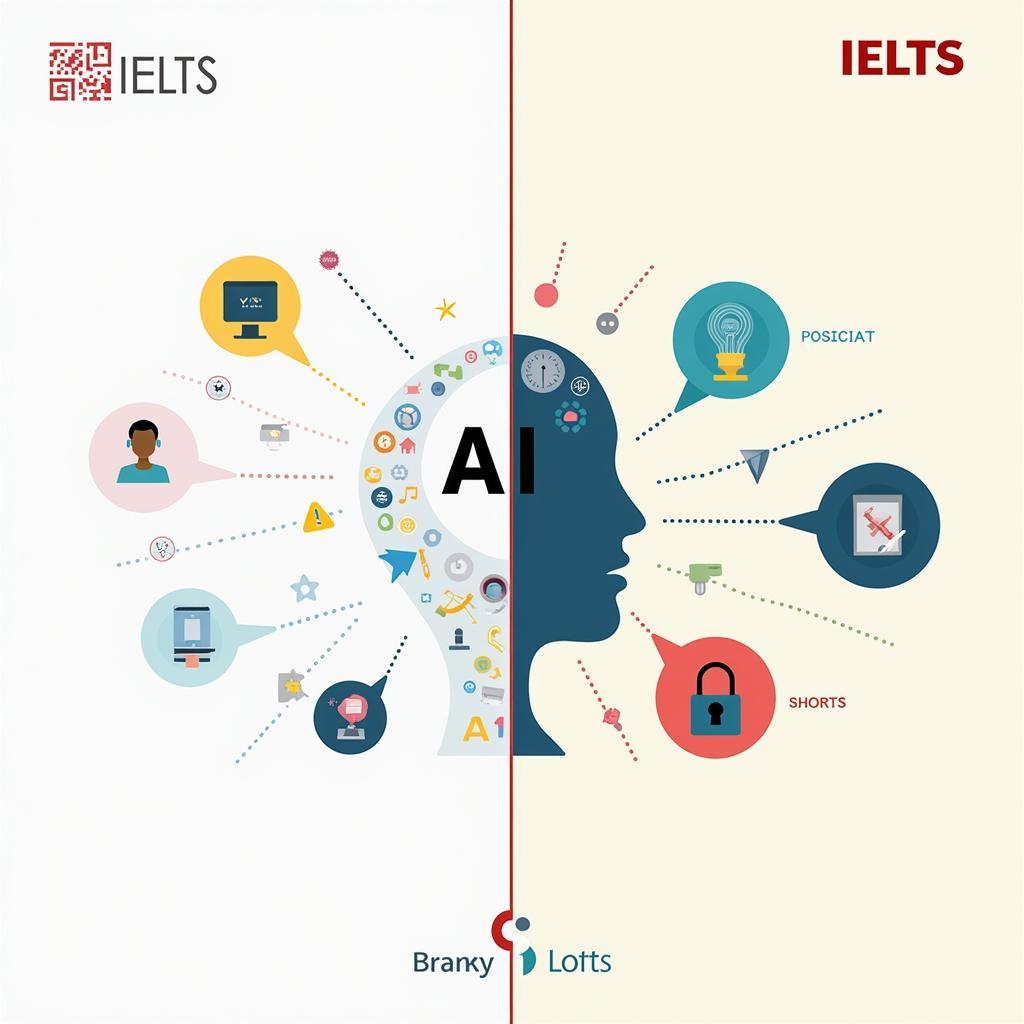Giới Thiệu Về Chủ Đề Nghệ Thuật Trong IELTS Writing
Chủ đề về vai trò của nghệ thuật trong việc định hình các cuộc thảo luận xã hội và chính trị là một đề tài thường xuyên xuất hiện trong IELTS Writing Task 2, đặc biệt trong các kỳ thi từ năm 2020 đến nay. Đây là một chủ đề thuộc nhóm Society & Culture, yêu cầu thí sinh không chỉ thể hiện khả năng ngôn ngữ mà còn cần có sự hiểu biết về tác động của nghệ thuật đến đời sống cộng đồng.
Theo thống kê từ các trang web uy tín như IELTS-blog.com và IELTSLiz.com, các câu hỏi liên quan đến nghệ thuật và ảnh hưởng xã hội xuất hiện trung bình 2-3 lần mỗi năm trên toàn cầu. Đề tài này đặc biệt phổ biến tại các trung tâm thi ở châu Á và châu Âu.
Trong bài viết này, bạn sẽ được học:
- 3 bài mẫu hoàn chỉnh ở các band điểm 5-6, 6.5-7 và 8-9
- Phân tích chi tiết từng tiêu chí chấm điểm
- 15+ từ vựng và collocations quan trọng về chủ đề nghệ thuật
- 6 cấu trúc câu giúp tăng band điểm ngay lập tức
- Các lỗi sai phổ biến của học viên Việt Nam và cách khắc phục
Các đề thi thực tế đã xuất hiện:
- “Some people believe that art gives meaning to our lives, while others argue it is just a distraction. Discuss both views and give your opinion.” (British Council, tháng 3/2023)
- “Public funding for the arts has become increasingly controversial. To what extent do you agree or disagree that governments should support artists?” (IDP, tháng 9/2022)
- “Art can challenge social norms and inspire political change. Do you agree or disagree?” (tháng 6/2023)
Đề Writing Task 2 Thực Hành
Some people think that art is an essential subject for children at school, while others think it is a waste of time. Discuss both views and give your own opinion. In what ways can art influence political and social discourse in contemporary society?
Dịch đề: Một số người cho rằng nghệ thuật là môn học thiết yếu cho trẻ em ở trường, trong khi những người khác cho rằng đó là lãng phí thời gian. Thảo luận cả hai quan điểm và đưa ra ý kiến của bạn. Nghệ thuật có thể ảnh hưởng đến các cuộc thảo luận chính trị và xã hội trong xã hội đương đại bằng những cách nào?
Phân tích đề bài:
Dạng câu hỏi: Đây là dạng đề kết hợp “Discuss both views and give your opinion” với câu hỏi mở rộng “In what ways…”. Đề bài yêu cầu thí sinh:
- Thảo luận hai quan điểm trái ngược về việc dạy nghệ thuật trong trường học
- Đưa ra ý kiến cá nhân
- Giải thích cách nghệ thuật ảnh hưởng đến xã hội và chính trị
Giải thích thuật ngữ quan trọng:
- Essential subject: môn học thiết yếu, không thể thiếu trong chương trình giáo dục
- Political and social discourse: các cuộc thảo luận, tranh luận về vấn đề xã hội và chính trị
- Contemporary society: xã hội hiện đại, đương đại
Những lỗi thường gặp của học viên Việt Nam:
- Chỉ tập trung vào phần thảo luận về giáo dục mà bỏ qua phần ảnh hưởng đến xã hội-chính trị
- Không đưa ra ý kiến cá nhân rõ ràng
- Viết quá chung chung, thiếu ví dụ cụ thể về các tác phẩm nghệ thuật đã tạo ra thay đổi xã hội
- Sử dụng từ “art” lặp đi lặp lại mà không dùng từ đồng nghĩa
Cách tiếp cận chiến lược:
- Đoạn mở bài: Paraphrase đề bài và nêu rõ cấu trúc bài viết
- Thân bài 1: Thảo luận quan điểm cho rằng nghệ thuật là thiết yếu (kết nối với vai trò xã hội-chính trị)
- Thân bài 2: Thảo luận quan điểm cho rằng nghệ thuật lãng phí thời gian
- Thân bài 3: Ý kiến cá nhân + giải thích chi tiết cách nghệ thuật ảnh hưởng đến xã hội-chính trị
- Kết bài: Tóm tắt và nhấn mạnh lập trường
Bài Mẫu Band 8-9
Bài viết Band 8-9 phải thể hiện sự tinh tế trong lập luận, sử dụng từ vựng phong phú và chính xác, cấu trúc câu đa dạng, đồng thời trả lời đầy đủ tất cả các phần của câu hỏi một cách mạch lạc và thuyết phục.
The debate surrounding the inclusion of art in school curricula has intensified in recent years, with proponents championing its essential value while critics dismiss it as an unnecessary diversion. While I acknowledge the practical concerns raised by the latter group, I firmly believe that art education is indispensable, particularly given its profound capacity to shape social consciousness and political engagement in contemporary society.
Those who advocate for compulsory art education argue that it cultivates critical thinking and emotional intelligence that extend far beyond aesthetic appreciation. By exposing students to diverse artistic expressions, schools nurture individuals capable of questioning established norms and envisioning alternative societal structures. For instance, studying protest art from the Civil Rights Movement enables young learners to understand how visual imagery can challenge systemic injustice. Moreover, art education fosters empathy by encouraging students to perceive the world through multiple perspectives, a skill increasingly vital in our polarized global landscape.
Conversely, opponents contend that in an era prioritizing STEM competencies and digital literacy, art represents an inefficient allocation of limited educational resources. They argue that practical skills such as coding and data analysis offer more tangible career prospects than painting or sculpture. From this pragmatic standpoint, schools facing budget constraints should concentrate on subjects with demonstrable economic returns rather than subjective creative pursuits.
However, this utilitarian perspective overlooks art’s distinctive role as a catalyst for social and political discourse. Throughout history, artistic works have functioned as powerful vehicles for challenging authority and mobilizing collective action. Picasso’s “Guernica” galvanized international opposition to fascism, while Banksy’s contemporary street art continues to provoke dialogue about immigration and inequality. In the digital age, artistic expression through memes, graphic design, and multimedia installations has democratized political commentary, enabling marginalized voices to contest dominant narratives. Furthermore, art provides a non-confrontational medium through which societies can process trauma, reconcile historical grievances, and imagine more equitable futures. The Truth and Reconciliation Commission in South Africa, for example, employed theatrical performances and visual art to facilitate national healing.
In conclusion, while acknowledging resource constraints, I maintain that art education merits prioritization due to its unparalleled capacity to develop critical consciousness and facilitate meaningful engagement with pressing social issues. Rather than viewing art as peripheral, educational policymakers should recognize it as foundational to cultivating the thoughtful, empathetic citizens necessary for addressing our era’s complex challenges.
Phân Tích Band Điểm
| Tiêu chí | Band | Nhận xét |
|---|---|---|
| Task Response (Hoàn thành yêu cầu) | 9.0 | Bài viết trả lời đầy đủ tất cả các phần của câu hỏi một cách sâu sắc và cân bằng. Quan điểm cá nhân được trình bày rõ ràng ngay từ đầu và được phát triển xuyên suốt bài. Phần thảo luận về cách nghệ thuật ảnh hưởng đến xã hội-chính trị được tích hợp khéo léo với các ví dụ cụ thể (Guernica, Banksy, Nam Phi). Mỗi ý tưởng được phát triển đầy đủ với lý lẽ thuyết phục. |
| Coherence & Cohesion (Mạch lạc & Liên kết) | 9.0 | Cấu trúc bài rất logic với sự chuyển đoạn mượt mà. Sử dụng đa dạng từ nối và cụm liên kết tinh tế (While I acknowledge, Conversely, However, Furthermore). Mỗi đoạn có chủ đề rõ ràng và các câu liên kết chặt chẽ với nhau. Không có sự lặp lại máy móc. |
| Lexical Resource (Từ vựng) | 9.0 | Từ vựng phong phú, chính xác và phù hợp với ngữ cảnh học thuật (indispensable, aesthetic appreciation, utilitarian perspective, catalyst, galvanized, democratized). Sử dụng collocations tự nhiên (cultivates critical thinking, mobilizing collective action, contest dominant narratives). Paraphrasing hiệu quả tránh lặp từ. Không có lỗi từ vựng. |
| Grammatical Range & Accuracy (Ngữ pháp) | 9.0 | Sử dụng đa dạng cấu trúc câu phức tạp một cách chính xác (mệnh đề quan hệ, phân từ, câu chẻ, đảo ngữ ẩn). Các thì động từ được sử dụng chính xác. Câu dài được kiểm soát tốt với dấu câu chính xác. Không có lỗi ngữ pháp đáng kể. |
Các Yếu Tố Giúp Bài Này Được Chấm Điểm Cao
-
Lập trường rõ ràng ngay từ đầu: Câu thesis statement “I firmly believe that art education is indispensable” thể hiện quan điểm cá nhân mạnh mẽ, không mơ hồ, đáp ứng yêu cầu “give your opinion”.
-
Tích hợp câu trả lời cho cả hai phần của đề bài: Thay vì tách biệt, tác giả khéo léo kết nối việc dạy nghệ thuật ở trường với vai trò xã hội-chính trị của nó, tạo sự liên kết chặt chẽ giữa các phần.
-
Sử dụng ví dụ cụ thể và đa dạng: Các ví dụ như “Guernica” của Picasso, nghệ thuật đường phố của Banksy, và Ủy ban Hòa giải ở Nam Phi không chỉ minh họa cho lập luận mà còn cho thấy kiến thức rộng của tác giả.
-
Từ vựng học thuật tinh tế: Sử dụng các cụm từ như “indispensable”, “catalyst for social discourse”, “democratized political commentary” thể hiện vốn từ vựng cao cấp nhưng vẫn tự nhiên, không gượng ép.
-
Cấu trúc câu phức tạp nhưng rõ ràng: Các câu dài như “By exposing students to diverse artistic expressions, schools nurture individuals capable of questioning established norms” sử dụng cụm phân từ và mệnh đề phụ thuộc một cách chính xác.
-
Thừa nhận quan điểm đối lập: Cụm “While I acknowledge the practical concerns” và đoạn văn về quan điểm phản đối cho thấy khả năng tư duy phản biện, không thiên vị một chiều.
-
Kết bài mạnh mẽ: Phần kết không chỉ tóm tắt mà còn mở rộng ý tưởng bằng cách đề xuất hành động cho các nhà hoạch định chính sách, thể hiện tư duy sâu sắc về vấn đề.
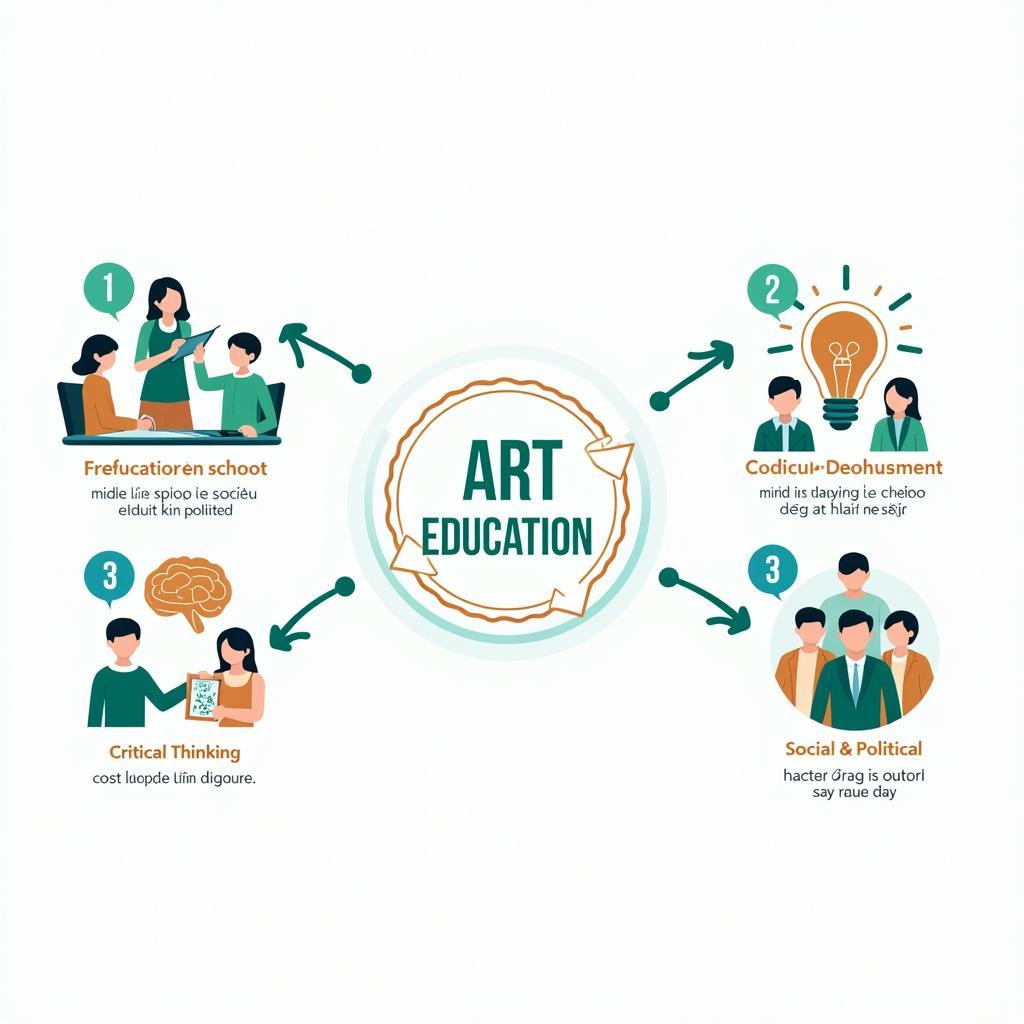 Sơ đồ phân tích vai trò nghệ thuật trong xã hội đương đại cho IELTS Writing Task 2
Sơ đồ phân tích vai trò nghệ thuật trong xã hội đương đại cho IELTS Writing Task 2
Bài Mẫu Band 6.5-7
Bài viết Band 6.5-7 thể hiện khả năng sử dụng ngôn ngữ tốt với ý tưởng rõ ràng, nhưng chưa có sự tinh tế và chiều sâu như Band 8-9. Vẫn còn một số hạn chế về từ vựng và cấu trúc câu.
The question of whether art should be taught in schools is a controversial topic. While some people believe it is essential, others think it wastes valuable time that could be spent on more practical subjects. In my opinion, art plays an important role in education and society, and I will discuss both viewpoints in this essay.
On the one hand, supporters of art education argue that it provides many benefits for children’s development. Learning art helps students develop creativity and imagination, which are important skills in many careers. For example, designers, architects, and even engineers need creative thinking to solve problems. Additionally, art classes give students a way to express their emotions and reduce stress from academic pressure. This is especially important in countries like Vietnam where students face heavy workloads and exam stress.
On the other hand, critics claim that art is less important than subjects like mathematics, science, and languages. They believe that schools should focus on teaching practical skills that will help students get good jobs in the future. In today’s competitive job market, employers usually look for candidates with technical abilities rather than artistic talents. Therefore, spending too much time on art might disadvantage students when they look for employment.
However, I believe that art is valuable not only for individual development but also for its influence on society and politics. Throughout history, artists have used their work to comment on social issues and inspire change. For instance, during the Vietnam War, many artists created paintings and songs that protested against the conflict and raised awareness about its consequences. In modern society, street art and political cartoons continue to challenge government policies and start important conversations. Social media has made it easier for artists to share their messages and influence public opinion on topics like environmental protection and human rights.
In conclusion, although some people think art is not as important as other subjects, I believe it should remain part of the school curriculum because it develops essential skills and provides a powerful tool for social and political expression. Schools should try to balance practical subjects with creative ones to produce well-rounded citizens.
Phân Tích Band Điểm
| Tiêu chí | Band | Nhận xét |
|---|---|---|
| Task Response (Hoàn thành yêu cầu) | 6.5 | Bài viết trả lời được tất cả các phần của câu hỏi nhưng chưa sâu sắc. Quan điểm cá nhân có nêu rõ nhưng phát triển chưa đủ mạnh. Phần thảo luận về ảnh hưởng chính trị-xã hội có đề cập nhưng còn khá ngắn và chung chung. Các ý tưởng được phát triển hợp lý nhưng thiếu độ tinh tế. |
| Coherence & Cohesion (Mạch lạc & Liên kết) | 7.0 | Cấu trúc bài rõ ràng với các đoạn văn được tổ chức logic. Sử dụng từ nối phổ biến (On the one hand, On the other hand, However, Therefore) một cách chính xác. Mỗi đoạn có chủ đề rõ ràng. Tuy nhiên, sự chuyển tiếp giữa các ý còn hơi máy móc, chưa mượt mà như Band 8-9. |
| Lexical Resource (Từ vựng) | 6.5 | Từ vựng đủ để diễn đạt ý tưởng một cách rõ ràng với một số cụm từ tốt (controversial topic, express emotions, competitive job market, raised awareness). Có cố gắng sử dụng paraphrase nhưng còn lặp một số từ như “important” và “art”. Collocations chủ yếu ở mức trung bình. Không có lỗi từ vựng nghiêm trọng. |
| Grammatical Range & Accuracy (Ngữ pháp) | 7.0 | Sử dụng kết hợp câu đơn và câu phức một cách chính xác. Có một số cấu trúc phức tạp (mệnh đề quan hệ, câu điều kiện) nhưng không đa dạng bằng Band 8-9. Các thì động từ được sử dụng chính xác. Có một số lỗi nhỏ nhưng không ảnh hưởng đến sự hiểu nghĩa. |
So Sánh Với Bài Band 8-9
1. Độ sâu của lập luận:
- Band 8-9: “By exposing students to diverse artistic expressions, schools nurture individuals capable of questioning established norms and envisioning alternative societal structures.” – Lập luận cụ thể về cách nghệ thuật phát triển tư duy phản biện.
- Band 6.5-7: “Learning art helps students develop creativity and imagination, which are important skills in many careers.” – Lập luận đúng nhưng còn khá chung chung.
2. Từ vựng và cụm từ:
- Band 8-9: Sử dụng “indispensable”, “catalyst”, “galvanized opposition”, “democratized political commentary” – từ vựng học thuật cao cấp và chính xác.
- Band 6.5-7: Sử dụng “important”, “helps students”, “good jobs” – từ vựng đủ nghĩa nhưng ở mức trung bình, lặp từ “important”.
3. Ví dụ minh họa:
- Band 8-9: Đưa ra các ví dụ cụ thể với tên tác phẩm và nghệ sĩ (Picasso’s Guernica, Banksy, Truth and Reconciliation Commission).
- Band 6.5-7: Ví dụ chung chung hơn (artists during Vietnam War, street art, political cartoons) không có tên cụ thể.
4. Cấu trúc câu:
- Band 8-9: “While I acknowledge the practical concerns raised by the latter group, I firmly believe…” – Câu phức tạp với mệnh đề nhượng bộ.
- Band 6.5-7: “While some people believe it is essential, others think it wastes valuable time…” – Cấu trúc đúng nhưng đơn giản hơn.
5. Sự kết nối giữa các ý:
- Band 8-9: Mỗi đoạn văn liên kết chặt chẽ với nhau, tạo thành một luồng lập luận mạch lạc từ giáo dục đến ảnh hưởng xã hội.
- Band 6.5-7: Các đoạn văn rõ ràng nhưng kết nối còn hơi rời rạc, đặc biệt là phần chuyển từ thảo luận giáo dục sang ảnh hưởng xã hội.
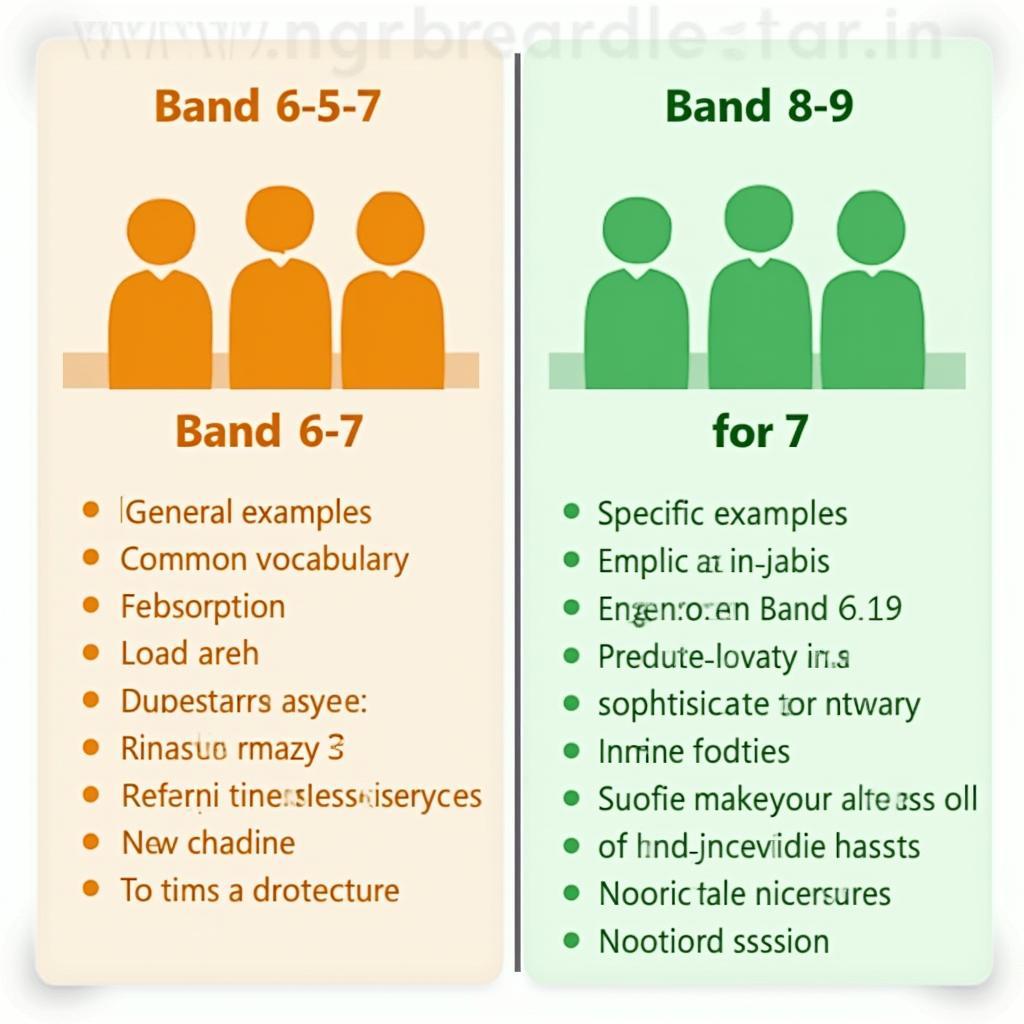 Bảng so sánh đặc điểm bài viết IELTS band 6.5-7 và band 8-9 về chủ đề nghệ thuật
Bảng so sánh đặc điểm bài viết IELTS band 6.5-7 và band 8-9 về chủ đề nghệ thuật
Bài Mẫu Band 5-6
Bài viết Band 5-6 thể hiện khả năng giao tiếp cơ bản với một số lỗi ngữ pháp và từ vựng hạn chế. Ý tưởng được trình bày nhưng chưa phát triển đầy đủ.
Nowadays, many people have different opinion about teaching art in school. Some people think art is very important subject for children, but other people think it is waste time. I will discuss both side and give my opinion.
First, art is important for children education. When children learn art, they can be more creative and can think different way. This is good for their future job because many job need creative people. For example, if you want to be designer or architect, you need to study art when you are young. Also, art make children happy and they can forget about stress from other subject like math or science. In my country Vietnam, student have too much homework and exam, so art class can help them relax.
However, some people think art is not useful subject. They think school should teach more important subject like math, science and English because these subject can help student find good job easier. In today world, company want to hire people who have technical skill, not people who can paint or draw. So if student spend too much time learn art, maybe they cannot get good score in other subject and cannot go to good university.
But I think art is important because it can change society and political. In the past, many artist make painting or music to show their idea about social problem. For example, some artist make picture about war to tell people war is bad. Also, nowadays people use art on internet to talk about problem in government or environment. When people see this art, they can understand the problem better and maybe they will do something to change it.
In conclusion, I think art should be teach in school because it help student develop their creative and also it is important for society. School need to teach both practical subject and art subject so student can have balance education.
Phân Tích Band Điểm
| Tiêu chí | Band | Nhận xét |
|---|---|---|
| Task Response (Hoàn thành yêu cầu) | 5.5 | Bài viết cố gắng trả lời cả hai phần của câu hỏi nhưng phát triển ý còn yếu. Quan điểm cá nhân có đề cập nhưng không rõ ràng và nhất quán. Phần thảo luận về ảnh hưởng chính trị-xã hội rất ngắn và thiếu ví dụ cụ thể. Nhiều ý tưởng chưa được giải thích đầy đủ. |
| Coherence & Cohesion (Mạch lạc & Liên kết) | 5.5 | Có cấu trúc cơ bản với mở bài, thân bài và kết bài nhưng sự kết nối giữa các ý còn yếu. Sử dụng từ nối đơn giản (First, However, Also, So, But) đôi khi không chính xác hoặc lặp lại. Thiếu topic sentence rõ ràng trong một số đoạn. Sự phát triển ý chưa logic hoàn toàn. |
| Lexical Resource (Từ vựng) | 5.5 | Từ vựng hạn chế với nhiều từ lặp lại (important, good, subject). Có một số lỗi word choice (waste time thay vì a waste of time, opinion thay vì opinions). Collocations không tự nhiên (think different way, make children happy). Paraphrasing rất hạn chế. Vẫn đủ để truyền đạt ý nghĩa cơ bản. |
| Grammatical Range & Accuracy (Ngữ pháp) | 5.5 | Sử dụng chủ yếu câu đơn với một số câu phức đơn giản. Có nhiều lỗi ngữ pháp: thiếu mạo từ (is very important subject), lỗi số ít-số nhiều (different opinion, other people think), lỗi thì (art make children happy), lỗi cấu trúc (cannot get good score). Tuy nhiên, các lỗi này không cản trở việc hiểu nghĩa tổng thể. |
Những Lỗi Sai Của Bài – Phân Tích & Giải Thích
| Lỗi sai | Loại lỗi | Sửa lại | Giải thích |
|---|---|---|---|
| different opinion | Lỗi số ít-số nhiều | different opinions | “Opinion” là danh từ đếm được, sau “many people” phải dùng số nhiều. Đây là lỗi phổ biến của học viên Việt vì tiếng Việt không chia danh từ số nhiều. |
| art is very important subject | Thiếu mạo từ | art is a very important subject | Danh từ đếm được số ít cần mạo từ “a/an”. Học viên Việt thường quên mạo từ vì tiếng Việt không có. |
| other people think | Lỗi word choice | others think | Sau “some people”, dùng “others” (không có “people” nữa) để tránh lặp. |
| it is waste time | Thiếu mạo từ | it is a waste of time | Cụm cố định “a waste of time” (việc lãng phí thời gian). Không thể bỏ “a” và “of”. |
| children education | Lỗi sở hữu cách | children’s education | Cần dùng sở hữu cách apostrophe + s để chỉ “giáo dục của trẻ em”. |
| can think different way | Thiếu giới từ | can think in different ways | Cần giới từ “in” và “ways” phải số nhiều. Cấu trúc đúng: “think in different ways”. |
| art make children happy | Lỗi chia động từ | art makes children happy | Chủ ngữ “art” là số ít nên động từ phải thêm “s”. Đây là lỗi subject-verb agreement rất phổ biến. |
| In today world | Lỗi sở hữu cách | In today’s world | “Today” cần thêm apostrophe + s để tạo tính từ sở hữu “của ngày nay”. |
| art is not useful subject | Thiếu mạo từ | art is not a useful subject | Cần mạo từ “a” trước danh từ đếm được số ít. |
| spend too much time learn art | Lỗi dạng động từ | spend too much time learning art | Sau “spend time” phải dùng V-ing. Cấu trúc: “spend time + V-ing”. |
| cannot get good score | Thiếu mạo từ | cannot get a good score / good scores | Cần mạo từ “a” cho số ít hoặc dùng số nhiều “scores”. |
| it can change society and political | Lỗi từ loại | it can change society and politics | “Political” là tính từ, cần dùng danh từ “politics” để song song với “society”. |
| many artist make painting | Thiếu số nhiều | many artists make paintings | “Many” + danh từ số nhiều. Cả “artist” và “painting” đều cần thêm “s”. |
| art should be teach | Lỗi thể bị động | art should be taught | Thể bị động: “should be + past participle”. “Teach” → “taught” (quá khứ phân từ bất quy tắc). |
| it help student develop | Nhiều lỗi | it helps students develop | “It” là số ít nên động từ cần “s”. “Student” phải số nhiều “students” vì không có mạo từ. |
Cách Cải Thiện Từ Band 6 Lên Band 7
1. Làm giàu vốn từ vựng và tránh lặp từ:
- Thay vì lặp “important” nhiều lần, hãy dùng: essential, crucial, vital, valuable, significant
- Thay vì “good job”, dùng: promising career, lucrative employment, professional opportunities
- Thay vì “change society”, dùng: transform social norms, reshape public opinion, influence discourse
2. Sử dụng cấu trúc câu phức tạp hơn:
- Kết hợp câu bằng mệnh đề quan hệ: “Art education, which develops creative thinking, is essential for children.”
- Dùng cụm phân từ: “Having learned art in school, students are better equipped to express complex ideas.”
- Sử dụng câu điều kiện: “Were schools to eliminate art programs, students would lose valuable opportunities for creative development.”
3. Phát triển ý tưởng đầy đủ hơn:
- Band 5-6: “Art make children happy” (quá đơn giản)
- Band 7+: “Art classes provide a therapeutic outlet for students, allowing them to process emotions and alleviate academic stress through creative expression.”
4. Sử dụng ví dụ cụ thể:
- Band 5-6: “Some artist make picture about war” (mơ hồ)
- Band 7+: “Picasso’s Guernica powerfully depicted the horrors of war, influencing public opinion against fascism” (cụ thể, có tên)
5. Cải thiện cohesion:
- Thay vì chỉ dùng “First, However, But”, hãy dùng: “Furthermore”, “Nevertheless”, “On the contrary”, “In addition to this”
- Sử dụng reference words: “this development”, “these benefits”, “such initiatives”
6. Chú ý ngữ pháp cơ bản:
- Luôn kiểm tra mạo từ a/an/the trước danh từ đếm được
- Chia động từ đúng với chủ ngữ (he/she/it + V-s)
- Dùng danh từ số nhiều sau “many”, “some”, “several”
- Kiểm tra dạng động từ sau giới từ (V-ing)
7. Viết câu thesis statement rõ ràng:
- Band 5-6: “I will discuss both side and give my opinion” (chung chung)
- Band 7+: “While acknowledging the practical concerns, I firmly believe that art education is indispensable for developing both individual creativity and social awareness.”
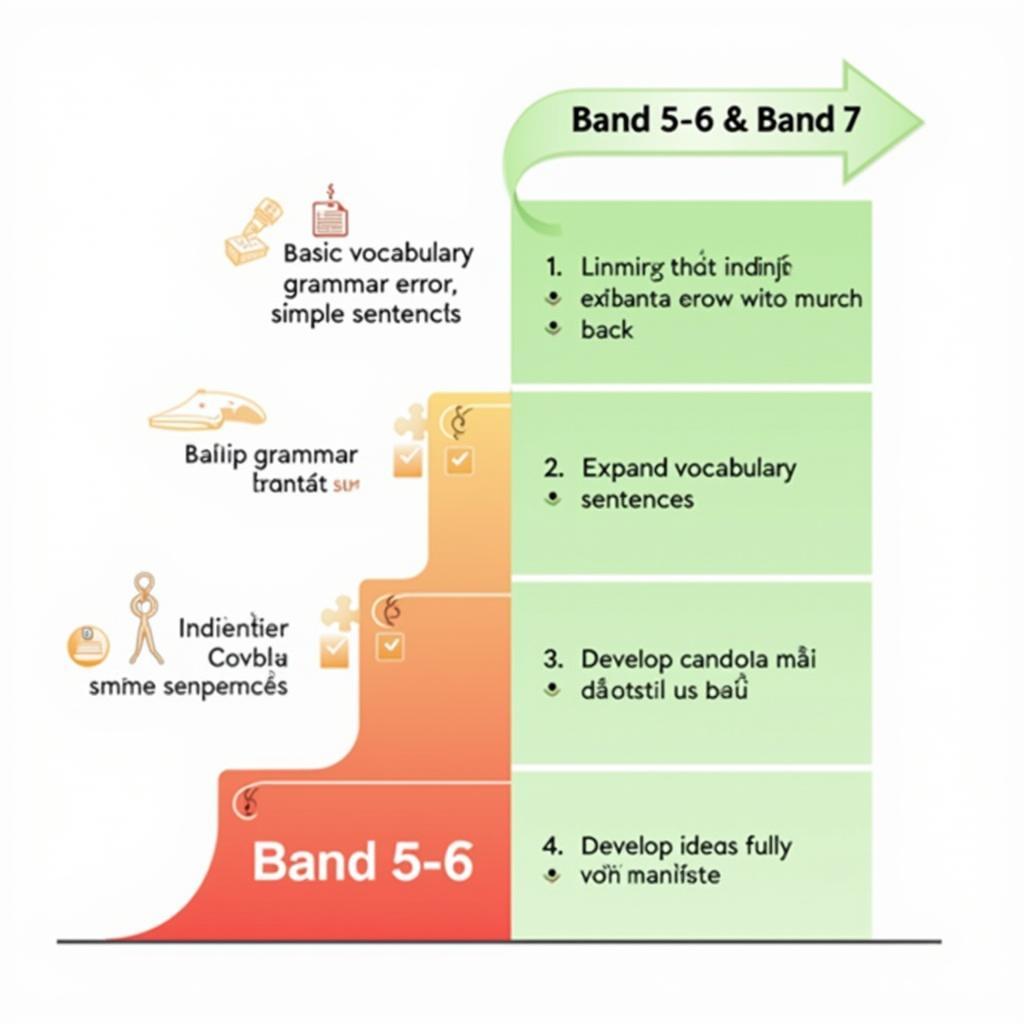 Infographic hướng dẫn cải thiện điểm IELTS Writing từ band 5-6 lên band 7
Infographic hướng dẫn cải thiện điểm IELTS Writing từ band 5-6 lên band 7
Từ Vựng Quan Trọng Cần Nhớ
| Từ/Cụm từ | Loại từ | Phiên âm | Nghĩa tiếng Việt | Ví dụ | Collocations |
|---|---|---|---|---|---|
| indispensable | Adj | /ˌɪndɪˈspensəbl/ | Không thể thiếu, tất yếu | Art education is indispensable for developing critical thinking. | indispensable tool/role/part |
| discourse | N | /ˈdɪskɔːrs/ | Diễn ngôn, cuộc thảo luận | Art shapes political discourse in contemporary society. | public discourse, political discourse, social discourse |
| catalyst | N | /ˈkætəlɪst/ | Chất xúc tác, tác nhân thúc đẩy | Art serves as a catalyst for social change. | catalyst for change, act as a catalyst |
| galvanize | V | /ˈɡælvənaɪz/ | Thúc đẩy mạnh mẽ, kích thích hành động | Picasso’s work galvanized opposition to war. | galvanize support/action/opposition |
| aesthetic appreciation | N phrase | /esˈθetɪk əˌpriːʃiˈeɪʃn/ | Sự cảm thúy thẩm mỹ | Art education goes beyond mere aesthetic appreciation. | develop aesthetic appreciation |
| mobilize | V | /ˈməʊbɪlaɪz/ | Huy động, vận động | Artists mobilize public opinion through their work. | mobilize support/resources/action |
| marginalized voices | N phrase | /ˈmɑːrdʒɪnəlaɪzd ˈvɔɪsɪz/ | Tiếng nói của nhóm bị thiệt thòi | Art amplifies marginalized voices in society. | give voice to marginalized communities |
| contest | V | /kənˈtest/ | Phản đối, thách thức | Street art contests dominant narratives. | contest a claim/idea/narrative |
| utilitarian perspective | N phrase | /ˌjuːtɪlɪˈteəriən pəˈspektɪv/ | Quan điểm thực dụng | Critics take a utilitarian perspective on education. | adopt a utilitarian approach |
| cultivate | V | /ˈkʌltɪveɪt/ | Trau dồi, nuôi dưỡng | Schools cultivate creativity through art programs. | cultivate skills/relationships/interest |
| democratize | V | /dɪˈmɒkrətaɪz/ | Dân chủ hóa, phổ cập | Social media has democratized artistic expression. | democratize access/information |
| empathy | N | /ˈempəθi/ | Sự đồng cảm | Art education fosters empathy and understanding. | develop empathy, show empathy |
| reconcile | V | /ˈrekənsaɪl/ | Hòa giải, dung hòa | Art helps societies reconcile historical grievances. | reconcile differences/conflicts |
| systemic injustice | N phrase | /sɪˈstemɪk ɪnˈdʒʌstɪs/ | Bất công có tính hệ thống | Protest art challenges systemic injustice. | address systemic injustice |
| polarized | Adj | /ˈpəʊləraɪzd/ | Phân cực, chia rẽ | Art bridges divides in our polarized society. | polarized debate/society/views |
Cấu Trúc Câu Dễ “Ăn Điểm” Cao
1. Câu nhượng bộ phức hợp (Complex Concessive Sentence)
Công thức: While/Although/Whilst + mệnh đề 1 (nhượng bộ), S + V + mệnh đề chính (quan điểm chính)
Ví dụ từ bài Band 8-9:
While I acknowledge the practical concerns raised by the latter group, I firmly believe that art education is indispensable.
Tại sao cấu trúc này ghi điểm cao:
Cấu trúc này thể hiện khả năng tư duy phản biện bằng cách thừa nhận quan điểm đối lập trước khi đưa ra lập trường của mình. Điều này cho thấy người viết không thiên vị một chiều mà có khả năng đánh giá cân bằng. Examiner đánh giá cao việc thí sinh có thể xử lý nhiều quan điểm phức tạp trong một câu.
Ví dụ bổ sung:
- Although budget constraints are a legitimate concern, eliminating art programs would deprive students of essential creative development.
- Whilst some argue for STEM prioritization, neglecting artistic education undermines holistic personal growth.
- While economic benefits matter, reducing education to mere job training ignores its broader societal function.
Lỗi thường gặp của học viên Việt Nam:
- Lỗi 1: Dùng cả “although” và “but” trong cùng một câu:
Although art is important, but it costs money(SAI) - Lỗi 2: Không có dấu phẩy giữa hai mệnh đề:
While art is valuable schools have limited budgets(SAI)
2. Cụm phân từ đầu câu (Participial Phrase)
Công thức: V-ing/Having + V-ed + object/complement, S + V + mệnh đề chính
Ví dụ từ bài Band 8-9:
By exposing students to diverse artistic expressions, schools nurture individuals capable of questioning established norms.
Tại sao cấu trúc này ghi điểm cao:
Cụm phân từ giúp câu văn ngắn gọn hơn so với việc dùng hai mệnh đề riêng biệt, thể hiện khả năng kiểm soát ngôn ngữ ở mức độ cao. Nó tạo sự đa dạng cấu trúc câu và giúp liên kết các ý tưởng một cách mượt mà hơn.
Ví dụ bổ sung:
- Having studied art history, students gain insights into different cultural perspectives and values.
- Recognizing art’s transformative power, policymakers should prioritize creative education in schools.
- Drawing inspiration from social movements, contemporary artists continue to challenge inequality through their work.
Lỗi thường gặp của học viên Việt Nam:
- Lỗi 1: Chủ ngữ của cụm phân từ và mệnh đề chính không giống nhau (Dangling modifier):
Having studied art, the understanding of culture improves(SAI – ai đã học art?) - Lỗi 2: Quên dấu phẩy sau cụm phân từ:
By learning art students become creative(SAI)
3. Câu bị động với động từ tường thuật (Reporting Verb Passive)
Công thức: It is + believed/argued/claimed/considered + that + S + V / S + is believed/argued/considered + to V
Ví dụ từ bài Band 8-9:
They argue that practical skills such as coding and data analysis offer more tangible career prospects than painting. (Có thể chuyển thành: It is argued that practical skills offer…)
Tại sao cấu trúc này ghi điểm cao:
Cấu trúc này tạo ra giọng văn học thuật, khách quan, tránh việc đổ lỗi trực tiếp cho một nhóm người cụ thể. Nó phù hợp với văn phong IELTS Academic và thể hiện sự tinh tế trong cách trình bày ý kiến.
Ví dụ bổ sung:
- It is widely acknowledged that art plays a crucial role in emotional development.
- Artistic expression is considered to be fundamental to human civilization.
- Art education is believed to enhance cognitive abilities beyond creative thinking.
Lỗi thường gặp của học viên Việt Nam:
- Lỗi 1: Dùng “to V” với động từ sai thì:
Art is considered to plays an important role(SAI – phải là “to play”) - Lỗi 2: Quên “that” trong cấu trúc “It is believed that”:
It is believed art is important(Thiếu “that”, tuy vẫn được chấp nhận nhưng kém trang trọng)
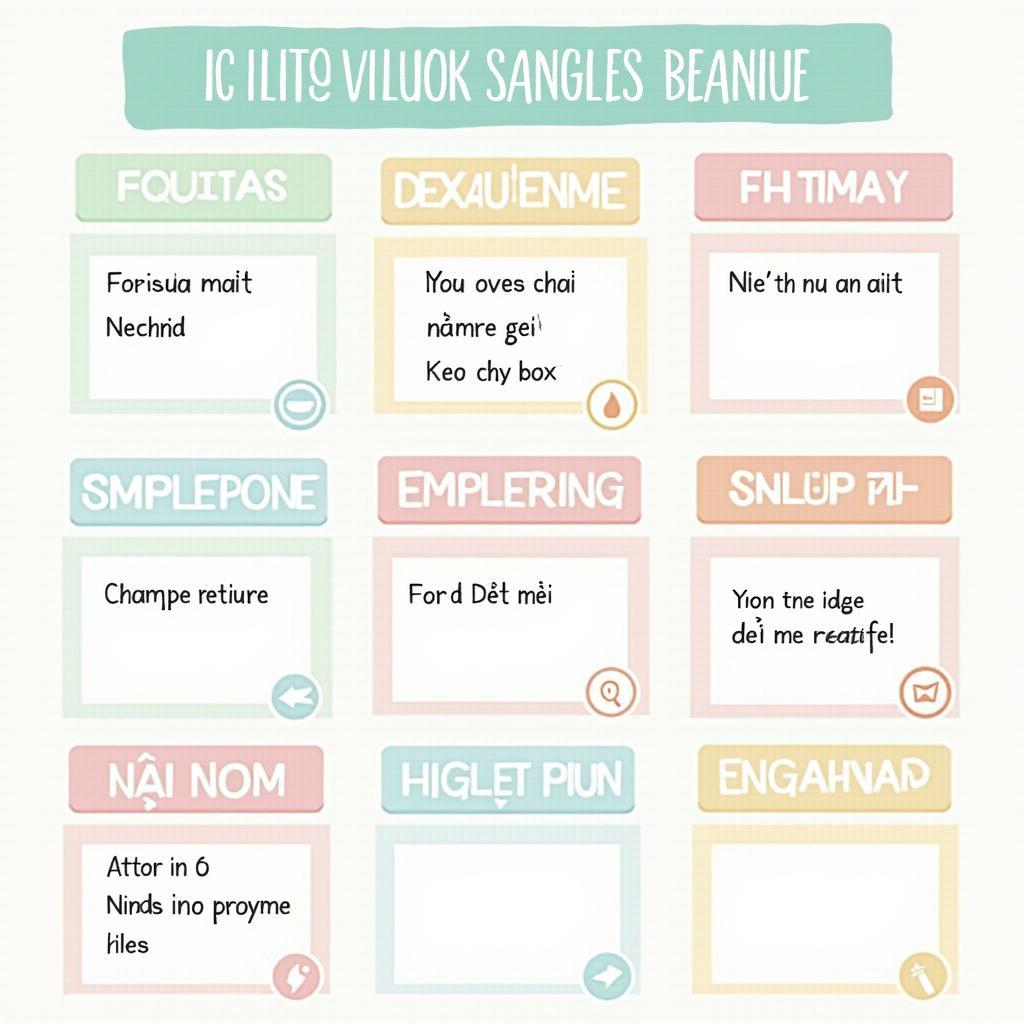 Bảng tóm tắt 6 cấu trúc câu quan trọng giúp tăng điểm IELTS Writing
Bảng tóm tắt 6 cấu trúc câu quan trọng giúp tăng điểm IELTS Writing
4. Mệnh đề quan hệ không xác định (Non-defining Relative Clause)
Công thức: S + (dấu phẩy) + which/who/where + V + (dấu phẩy) + V tiếp
Ví dụ từ bài Band 8-9:
Art education, which develops creative thinking, is essential for children.
Tại sao cấu trúc này ghi điểm cao:
Mệnh đề quan hệ không xác định cho phép thêm thông tin bổ sung vào câu một cách tự nhiên mà không làm ngắt quãng ý chính. Nó thể hiện khả năng xử lý cấu trúc câu phức tạp và tạo sự liền mạch trong văn bản.
Ví dụ bổ sung:
- Picasso’s Guernica, which depicted the horrors of war, influenced international opinion on fascism.
- Street art, which emerged from marginalized communities, has become a powerful tool for social commentary.
- Art education, which was once considered a luxury, is now recognized as fundamental to cognitive development.
Lỗi thường gặp của học viên Việt Nam:
- Lỗi 1: Quên dấu phẩy:
Art which develops creativity is important(SAI – thiếu dấu phẩy nếu là non-defining, hoặc câu đúng nhưng đổi nghĩa thành defining clause) - Lỗi 2: Dùng “that” thay vì “which” trong non-defining clause:
Art, that is important, should be taught(SAI – phải dùng “which”)
5. Đảo ngữ (Inversion) với “Not only… but also”
Công thức: Not only + auxiliary + S + V, but + S + also + V / Not only does S V, but S also V
Ví dụ áp dụng cho chủ đề:
Not only does art education foster creativity, but it also cultivates empathy and critical thinking essential for citizenship.
Tại sao cấu trúc này ghi điểm cao:
Đảo ngữ là dấu hiệu của trình độ ngôn ngữ cao, thường chỉ xuất hiện trong văn viết trang trọng. Nó giúp nhấn mạnh ý quan trọng và tạo sự đa dạng về cú pháp, khiến bài viết không đơn điệu.
Ví dụ bổ sung:
- Not only has art challenged social norms throughout history, but it has also inspired revolutionary political movements.
- Not only do artistic skills enhance employability, but they also contribute to overall well-being and life satisfaction.
- Not only can art express complex emotions, but it can also bridge cultural divides in diverse societies.
Lỗi thường gặp của học viên Việt Nam:
- Lỗi 1: Không đảo ngữ ở mệnh đề đầu:
Not only art is important but also it develops creativity(SAI – phải là “Not only is art important”) - Lỗi 2: Quên trợ động từ:
Not only art fosters creativity(SAI – phải là “Not only does art foster”)
6. Câu điều kiện loại 2 (Second Conditional) cho tình huống giả định
Công thức: If + S + V-ed/were, S + would/could/might + V (bare infinitive)
Ví dụ áp dụng cho chủ đề:
If schools eliminated art programs entirely, students would lose valuable opportunities to develop creative problem-solving abilities.
Tại sao cấu trúc này ghi điểm cao:
Câu điều kiện loại 2 cho phép thí sinh thảo luận về tình huống giả định và hệ quả của nó, thể hiện khả năng tư duy phản biện và phân tích các kịch bản khác nhau. Đây là kỹ năng quan trọng trong Task 2 khi cần đánh giá ưu-nhược điểm của các phương án.
Ví dụ bổ sung:
- Were governments to defund the arts completely, society would lose a crucial mechanism for social critique and political expression.
- If artists did not challenge conventional thinking, progress in social justice movements would be significantly slower.
- If education focused solely on technical skills, students might achieve economic success but lack the empathy necessary for social cohesion.
Lỗi thường gặp của học viên Việt Nam:
- Lỗi 1: Dùng “will” thay vì “would”:
If schools removed art, students will lose opportunities(SAI – phải dùng “would” cho điều kiện giả định) - Lỗi 2: Dùng sai thì ở mệnh đề “if”:
If schools will remove art, students would lose(SAI – mệnh đề “if” phải dùng quá khứ đơn)
Kết Bài
Chủ đề về vai trò của nghệ thuật trong việc định hình diễn ngôn xã hội và chính trị là một đề tài phong phú và thường xuyên xuất hiện trong IELTS Writing Task 2. Qua ba bài mẫu ở các band điểm khác nhau, bạn đã thấy được sự khác biệt rõ rệt trong cách phát triển ý tưởng, sử dụng từ vựng và cấu trúc ngữ pháp.
Để đạt band điểm cao (7+), hãy nhớ những điểm quan trọng sau:
Về nội dung: Trả lời đầy đủ tất cả các phần của câu hỏi, đưa ra ví dụ cụ thể thay vì nói chung chung, và thể hiện khả năng tư duy phản biện bằng cách xem xét nhiều góc độ.
Về từ vựng: Sử dụng từ vựng học thuật phù hợp (indispensable, catalyst, galvanize), tránh lặp từ bằng cách dùng paraphrase, và chú ý đến collocations tự nhiên.
Về ngữ pháp: Đa dạng hóa cấu trúc câu bằng cách kết hợp câu đơn, câu phức, mệnh đề quan hệ, cụm phân từ và đảo ngữ. Đặc biệt chú ý đến các lỗi cơ bản như mạo từ và chia động từ – những lỗi nhỏ này có thể kéo điểm xuống đáng kể.
Về tổ chức bài: Đảm bảo mỗi đoạn văn có một ý chính rõ ràng, sử dụng từ nối một cách tự nhiên (không máy móc), và tạo sự liên kết chặt chẽ giữa các ý tưởng.
Đối với học viên Việt Nam, hãy đặc biệt lưu ý:
- Luyện tập sử dụng mạo từ (a/an/the) đúng cách vì tiếng Việt không có mạo từ
- Chú ý đến số ít-số nhiều của danh từ
- Thực hành chia động từ theo chủ ngữ (đặc biệt ngôi thứ ba số ít)
- Học từ vựng theo cụm (collocations) thay vì học từ đơn lẻ
- Đọc nhiều bài mẫu band cao để làm quen với giọng văn học thuật
Cuối cùng, hãy nhớ rằng việc cải thiện kỹ năng viết là một quá trình liên tục. Thực hành viết thường xuyên, nhận phản hồi từ giáo viên hoặc bạn bè, và học hỏi từ những lỗi sai của mình. Với sự kiên trì và phương pháp đúng đắn, bạn hoàn toàn có thể đạt được band điểm mục tiêu của mình.
Chúc bạn học tốt và thành công trong kỳ thi IELTS!


